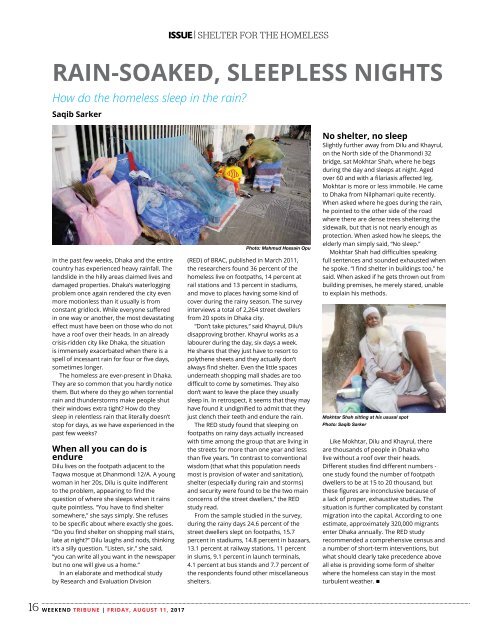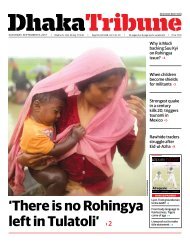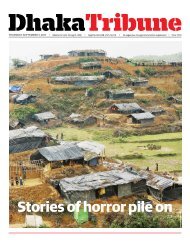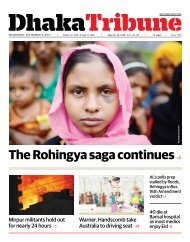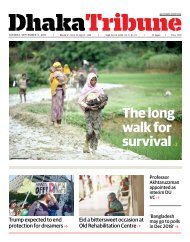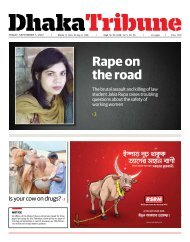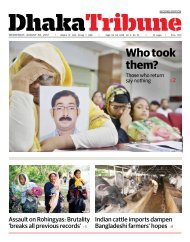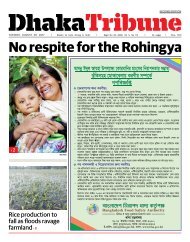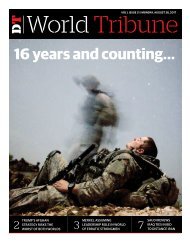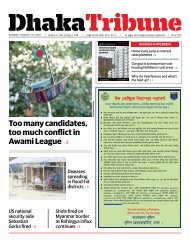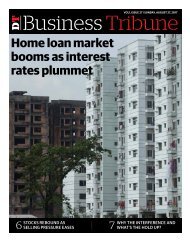Weekend-5-16
Create successful ePaper yourself
Turn your PDF publications into a flip-book with our unique Google optimized e-Paper software.
Issue | shelter for the homeless<br />
Rain-soaked, sleepless nights<br />
How do the homeless sleep in the rain?<br />
Saqib Sarker<br />
In the past few weeks, Dhaka and the entire<br />
country has experienced heavy rainfall. The<br />
landslide in the hilly areas claimed lives and<br />
damaged properties. Dhaka’s waterlogging<br />
problem once again rendered the city even<br />
more motionless than it usually is from<br />
constant gridlock. While everyone suffered<br />
in one way or another, the most devastating<br />
effect must have been on those who do not<br />
have a roof over their heads. In an already<br />
crisis-ridden city like Dhaka, the situation<br />
is immensely exacerbated when there is a<br />
spell of incessant rain for four or five days,<br />
sometimes longer.<br />
The homeless are ever-present in Dhaka.<br />
They are so common that you hardly notice<br />
them. But where do they go when torrential<br />
rain and thunderstorms make people shut<br />
their windows extra tight? How do they<br />
sleep in relentless rain that literally doesn’t<br />
stop for days, as we have experienced in the<br />
past few weeks?<br />
When all you can do is<br />
endure<br />
Dilu lives on the footpath adjacent to the<br />
Taqwa mosque at Dhanmondi 12/A. A young<br />
woman in her 20s, Dilu is quite indifferent<br />
to the problem, appearing to find the<br />
question of where she sleeps when it rains<br />
quite pointless. “You have to find shelter<br />
somewhere,” she says simply. She refuses<br />
to be specific about where exactly she goes.<br />
“Do you find shelter on shopping mall stairs,<br />
late at night?” Dilu laughs and nods, thinking<br />
it’s a silly question. “Listen, sir,” she said,<br />
“you can write all you want in the newspaper<br />
but no one will give us a home.”<br />
In an elaborate and methodical study<br />
by Research and Evaluation Division<br />
Photo: Mahmud Hossain Opu<br />
(RED) of BRAC, published in March 2011,<br />
the researchers found 36 percent of the<br />
homeless live on footpaths, 14 percent at<br />
rail stations and 13 percent in stadiums,<br />
and move to places having some kind of<br />
cover during the rainy season. The survey<br />
interviews a total of 2,264 street dwellers<br />
from 20 spots in Dhaka city.<br />
“Don’t take pictures,” said Khayrul, Dilu’s<br />
disapproving brother. Khayrul works as a<br />
labourer during the day, six days a week.<br />
He shares that they just have to resort to<br />
polythene sheets and they actually don’t<br />
always find shelter. Even the little spaces<br />
underneath shopping mall shades are too<br />
difficult to come by sometimes. They also<br />
don’t want to leave the place they usually<br />
sleep in. In retrospect, it seems that they may<br />
have found it undignified to admit that they<br />
just clench their teeth and endure the rain.<br />
The RED study found that sleeping on<br />
footpaths on rainy days actually increased<br />
with time among the group that are living in<br />
the streets for more than one year and less<br />
than five years. “In contrast to conventional<br />
wisdom (that what this population needs<br />
most is provision of water and sanitation),<br />
shelter (especially during rain and storms)<br />
and security were found to be the two main<br />
concerns of the street dwellers,” the RED<br />
study read.<br />
From the sample studied in the survey,<br />
during the rainy days 24.6 percent of the<br />
street dwellers slept on footpaths, 15.7<br />
percent in stadiums, 14.8 percent in bazaars,<br />
13.1 percent at railway stations, 11 percent<br />
in slums, 9.1 percent in launch terminals,<br />
4.1 percent at bus stands and 7.7 percent of<br />
the respondents found other miscellaneous<br />
shelters.<br />
No shelter, no sleep<br />
Slightly further away from Dilu and Khayrul,<br />
on the North side of the Dhanmondi 32<br />
bridge, sat Mokhtar Shah, where he begs<br />
during the day and sleeps at night. Aged<br />
over 60 and with a filariasis affected leg,<br />
Mokhtar is more or less immobile. He came<br />
to Dhaka from Nilphamari quite recently.<br />
When asked where he goes during the rain,<br />
he pointed to the other side of the road<br />
where there are dense trees sheltering the<br />
sidewalk, but that is not nearly enough as<br />
protection. When asked how he sleeps, the<br />
elderly man simply said, “No sleep.”<br />
Mokhtar Shah had difficulties speaking<br />
full sentences and sounded exhausted when<br />
he spoke. “I find shelter in buildings too,” he<br />
said. When asked if he gets thrown out from<br />
building premises, he merely stared, unable<br />
to explain his methods.<br />
Mokhtar Shah sitting at his ususal spot<br />
Photo: Saqib Sarker<br />
Like Mokhtar, Dilu and Khayrul, there<br />
are thousands of people in Dhaka who<br />
live without a roof over their heads.<br />
Different studies find different numbers -<br />
one study found the number of footpath<br />
dwellers to be at 15 to 20 thousand, but<br />
these figures are inconclusive because of<br />
a lack of proper, exhaustive studies. The<br />
situation is further complicated by constant<br />
migration into the capital. According to one<br />
estimate, approximately 320,000 migrants<br />
enter Dhaka annually. The RED study<br />
recommended a comprehensive census and<br />
a number of short-term interventions, but<br />
what should clearly take precedence above<br />
all else is providing some form of shelter<br />
where the homeless can stay in the most<br />
turbulent weather. •<br />
<strong>16</strong> WEEKEND TRIBUNE | FRIDAY, AUGUST 11, 2017


